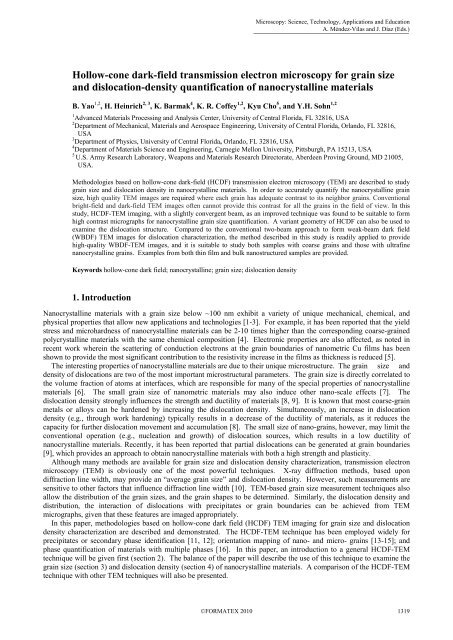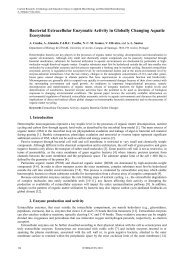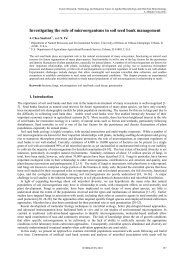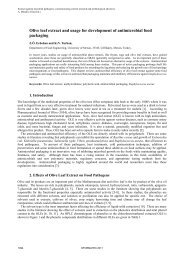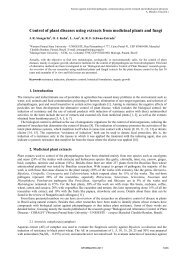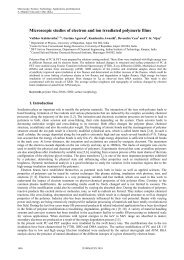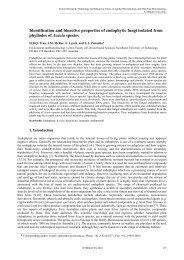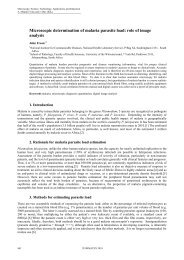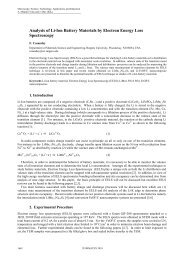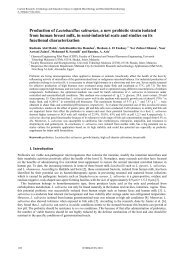Hollow-cone dark-field transmission electron microscopy for grain ...
Hollow-cone dark-field transmission electron microscopy for grain ...
Hollow-cone dark-field transmission electron microscopy for grain ...
Create successful ePaper yourself
Turn your PDF publications into a flip-book with our unique Google optimized e-Paper software.
<strong>Hollow</strong>-<strong>cone</strong> <strong>dark</strong>-<strong>field</strong> <strong>transmission</strong> <strong>electron</strong> <strong>microscopy</strong> <strong>for</strong> <strong>grain</strong> size<br />
and dislocation-density quantification of nanocrystalline materials<br />
B. Yao 1,2 , H. Heinrich 2, 3 , K. Barmak 4 , K. R. Coffey 1,2 , Kyu Cho 5 , and Y.H. Sohn 1,2<br />
1<br />
Advanced Materials Processing and Analysis Center, University of Central Florida, FL 32816, USA<br />
2<br />
Department of Mechanical, Materials and Aerospace Engineering, University of Central Florida, Orlando, FL 32816,<br />
USA<br />
3<br />
Department of Physics, University of Central Florida, Orlando, FL 32816, USA<br />
4<br />
Department of Materials Science and Engineering, Carnegie Mellon University, Pittsburgh, PA 15213, USA<br />
5<br />
U.S. Army Research Laboratory, Weapons and Materials Research Directorate, Aberdeen Proving Ground, MD 21005,<br />
USA.<br />
Methodologies based on hollow-<strong>cone</strong> <strong>dark</strong>-<strong>field</strong> (HCDF) <strong>transmission</strong> <strong>electron</strong> <strong>microscopy</strong> (TEM) are described to study<br />
<strong>grain</strong> size and dislocation density in nanocrystalline materials. In order to accurately quantify the nanocrystalline <strong>grain</strong><br />
size, high quality TEM images are required where each <strong>grain</strong> has adequate contrast to its neighbor <strong>grain</strong>s. Conventional<br />
bright-<strong>field</strong> and <strong>dark</strong>-<strong>field</strong> TEM images often cannot provide this contrast <strong>for</strong> all the <strong>grain</strong>s in the <strong>field</strong> of view. In this<br />
study, HCDF-TEM imaging, with a slightly convergent beam, as an improved technique was found to be suitable to <strong>for</strong>m<br />
high contrast micrographs <strong>for</strong> nanocrystalline <strong>grain</strong> size quantification. A variant geometry of HCDF can also be used to<br />
examine the dislocation structure. Compared to the conventional two-beam approach to <strong>for</strong>m weak-beam <strong>dark</strong> <strong>field</strong><br />
(WBDF) TEM images <strong>for</strong> dislocation characterization, the method described in this study is readily applied to provide<br />
high-quality WBDF-TEM images, and it is suitable to study both samples with coarse <strong>grain</strong>s and those with ultrafine<br />
nanocrystalline <strong>grain</strong>s. Examples from both thin film and bulk nanostructured samples are provided.<br />
Keywords hollow-<strong>cone</strong> <strong>dark</strong> <strong>field</strong>; nanocrystalline; <strong>grain</strong> size; dislocation density<br />
1. Introduction<br />
Microscopy: Science, Technology, Applications and Education<br />
______________________________________________<br />
A. Méndez-Vilas and J. Díaz (Eds.)<br />
Nanocrystalline materials with a <strong>grain</strong> size below ~100 nm exhibit a variety of unique mechanical, chemical, and<br />
physical properties that allow new applications and technologies [1-3]. For example, it has been reported that the yield<br />
stress and microhardness of nanocrystalline materials can be 2-10 times higher than the corresponding coarse-<strong>grain</strong>ed<br />
polycrystalline materials with the same chemical composition [4]. Electronic properties are also affected, as noted in<br />
recent work wherein the scattering of conduction <strong>electron</strong>s at the <strong>grain</strong> boundaries of nanometric Cu films has been<br />
shown to provide the most significant contribution to the resistivity increase in the films as thickness is reduced [5].<br />
The interesting properties of nanocrystalline materials are due to their unique microstructure. The <strong>grain</strong> size and<br />
density of dislocations are two of the most important microstructural parameters. The <strong>grain</strong> size is directly correlated to<br />
the volume fraction of atoms at interfaces, which are responsible <strong>for</strong> many of the special properties of nanocrystalline<br />
materials [6]. The small <strong>grain</strong> size of nanometric materials may also induce other nano-scale effects [7]. The<br />
dislocation density strongly influences the strength and ductility of materials [8, 9]. It is known that most coarse-<strong>grain</strong><br />
metals or alloys can be hardened by increasing the dislocation density. Simultaneously, an increase in dislocation<br />
density (e.g., through work hardening) typically results in a decrease of the ductility of materials, as it reduces the<br />
capacity <strong>for</strong> further dislocation movement and accumulation [8]. The small size of nano-<strong>grain</strong>s, however, may limit the<br />
conventional operation (e.g., nucleation and growth) of dislocation sources, which results in a low ductility of<br />
nanocrystalline materials. Recently, it has been reported that partial dislocations can be generated at <strong>grain</strong> boundaries<br />
[9], which provides an approach to obtain nanocrystalline materials with both a high strength and plasticity.<br />
Although many methods are available <strong>for</strong> <strong>grain</strong> size and dislocation density characterization, <strong>transmission</strong> <strong>electron</strong><br />
<strong>microscopy</strong> (TEM) is obviously one of the most powerful techniques. X-ray diffraction methods, based upon<br />
diffraction line width, may provide an “average <strong>grain</strong> size” and dislocation density. However, such measurements are<br />
sensitive to other factors that influence diffraction line width [10]. TEM-based <strong>grain</strong> size measurement techniques also<br />
allow the distribution of the <strong>grain</strong> sizes, and the <strong>grain</strong> shapes to be determined. Similarly, the dislocation density and<br />
distribution, the interaction of dislocations with precipitates or <strong>grain</strong> boundaries can be achieved from TEM<br />
micrographs, given that these features are imaged appropriately.<br />
In this paper, methodologies based on hollow-<strong>cone</strong> <strong>dark</strong> <strong>field</strong> (HCDF) TEM imaging <strong>for</strong> <strong>grain</strong> size and dislocation<br />
density characterization are described and demonstrated. The HCDF-TEM technique has been employed widely <strong>for</strong><br />
precipitates or secondary phase identification [11, 12]; orientation mapping of nano- and micro- <strong>grain</strong>s [13-15]; and<br />
phase quantification of materials with multiple phases [16]. In this paper, an introduction to a general HCDF-TEM<br />
technique will be given first (section 2). The balance of the paper will describe the use of this technique to examine the<br />
<strong>grain</strong> size (section 3) and dislocation density (section 4) of nanocrystalline materials. A comparison of the HCDF-TEM<br />
technique with other TEM techniques will also be presented.<br />
©FORMATEX 2010 1319
Microscopy: Science, Technology, Applications and Education<br />
A. ______________________________________________<br />
Méndez-Vilas and J. Díaz (Eds.)<br />
2. Introduction to the HCDF-TEM technique<br />
The HCDF-TEM imaging described in this work was conducted with a FEI/Tecnai F30 TEM/STEM microscope with a<br />
<strong>field</strong> emission gun operating at 300 keV. In the HCDF-TEM mode, the incident <strong>electron</strong> beam is tilted at a fixed angle<br />
with respect to the optical axis of the objective lens, and a rotation of the tilted beam <strong>for</strong>ms a hollow-<strong>cone</strong> illumination.<br />
A ray diagram of the HCDF-TEM is shown in Fig. 1(a). On the viewing screen of the microscope, the diffraction<br />
pattern is deflected to allow a portion of a selected diffraction ring (e.g., 111 or 200) to coincide with a centered<br />
objective aperture, as is normally done in conventional centered <strong>dark</strong>-<strong>field</strong> imaging. HCDF-TEM images are <strong>for</strong>med as<br />
the position of the diffraction pattern over the objective aperture is circumferentially scanned as the <strong>electron</strong> beam is<br />
rotated at the fixed angle to the optical axis. The geometry of the rotation of the diffraction pattern over the aperture is<br />
illustrated in Fig. 1(b). The beam rotation can be conducted automatically via the microscope control software, or<br />
manually through a mechanical probe. As will be described in detail below, a continuous rotation of <strong>electron</strong> beam is<br />
necessary in order to <strong>for</strong>m high-quality HCDF-TEM images <strong>for</strong> <strong>grain</strong> size quantification, where the <strong>grain</strong>-to-<strong>grain</strong><br />
contrast of all <strong>grain</strong>s in the <strong>field</strong> of view is concerned. For dislocation density characterization, however, the rotation is<br />
per<strong>for</strong>med manually, and the HCDF-TEM images are not <strong>for</strong>med using the whole diffraction ring(s), but only from the<br />
centered diffraction vector g.<br />
(a)<br />
e beam<br />
Optical axis<br />
Rotation trace<br />
Specimen<br />
View screen<br />
Fig. 1 (a). The ray diagram of HCDF-TEM technique, and (b) The diffraction plane configuration <strong>for</strong> HCDF TEM imaging [17].<br />
As reviewed previously, the HCDF-TEM techniques can be employed <strong>for</strong> a variety of applciations. The specific setup<br />
and operation procudures may vary significantly in different cases. This paper will focus on the application of<br />
HCDF-TEM to <strong>grain</strong> size and dislocation density characterization. Detailed descriptions of the techniques will be given<br />
in following sections.<br />
3. Grain size quantification of nanocrystalline materilas<br />
(b)<br />
TEM micrographs ideal <strong>for</strong> <strong>grain</strong>s size quantification should have most (and ideally all) <strong>grain</strong>s in the <strong>field</strong> of view<br />
having an adequately high contrast between adjacent <strong>grain</strong>s such that the <strong>grain</strong> boundary network is clearly identifiable.<br />
The idea of using the HCDF technique to obtain high quality micrographs is to maximize the diffraction contrast <strong>for</strong> all<br />
imaged <strong>grain</strong>s. Guided by this principle, the set-up of the HCDF imaging is modified as below. First of all, a<br />
continuous rotation of a slightly-convergent beam is used to <strong>for</strong>m the image. A high rotation speed of <strong>electron</strong> beam<br />
(10 rotations per second) and a relative long CCD integration time (about 1 second) are typically used to maximize the<br />
number of intensity averaging scans over the annular region. A slightly-convergent beam <strong>for</strong> has been found to aid<br />
practical operation. Generally, HCDF imaging is normally done using a parallel (non-divergent) <strong>electron</strong> beam.<br />
However, the HCDF image <strong>for</strong>med using a parallel beam has a very low intensity and, thus, a long CCD integration<br />
time is required to <strong>for</strong>m the images. The low intensity and the long integration time make it difficult to acquire high<br />
quality micrographs, because of sample drift and because of the inability to judge whether the image is in sharp focus.<br />
In order to increase the intensity of <strong>dark</strong>-<strong>field</strong> images, the beam is converged to about 40 mm in diameter on the<br />
viewing screen, which results in different semi-convergence angles at different magnifications. The beam convergence<br />
de-focuses the diffraction pattern at the diffraction plane (or the plane of the objective aperture) and introduces some<br />
uncertainty regarding which diffracted <strong>electron</strong>s are contributing to the HCDF images. Nevertheless, the imaging<br />
<strong>electron</strong>s are limited by the size of the objective aperture. The aperture size can then be optimized to provide the best<br />
image <strong>for</strong> <strong>grain</strong> identification. As in the normal practice <strong>for</strong> HCDF imaging, the <strong>electron</strong> beam tilt angle is adjusted (in<br />
our case, typically 0.3˚~0.4˚) so that the direct beam is just out of the objective aperture and does not contribute to the<br />
micrographs. It should be noted that even with this slightly convergent illumination, high quality HCDF micrographs<br />
<strong>for</strong>med with several diffraction rings still require a much longer CCD integration time (approximately a factor of ten<br />
increase) compared to that used <strong>for</strong> BF images.<br />
1320 ©FORMATEX 2010
Three micrographs, a HCDF, a BF, and a conventional DF of the same <strong>field</strong> of view in a 40 nm-thick Cu film<br />
annealed at 600˚C <strong>for</strong> 30 minutes are shown in Figs. 2 (a), (b), and (c), respectively. A description of the preparation of<br />
the Cu films and TEM samples can be found elsewhere [20]. The BF-TEM image has a low <strong>grain</strong>-to-<strong>grain</strong> contrast <strong>for</strong><br />
most <strong>grain</strong>s because of the uni<strong>for</strong>mly high intensity of the transmitted beam. Although a few <strong>grain</strong>s satisfying the<br />
Bragg diffraction condition can be identified, the weak diffraction contrast <strong>for</strong> most <strong>grain</strong>s prevents identification of all<br />
but a few of the <strong>grain</strong> boundaries. Conventional DF-TEM images provide high contrast <strong>for</strong> the <strong>grain</strong>s whose diffracted<br />
<strong>electron</strong>s pass through the objective aperture, but provide lower <strong>grain</strong>-to-<strong>grain</strong> contrast than BF imaging <strong>for</strong> the majority<br />
of the <strong>grain</strong>s present. The HCDF-TEM technique described above uses one or more diffraction rings of polycrystalline<br />
samples (depending on the size of the objective aperture) to <strong>for</strong>m the image. Consequently, most <strong>grain</strong>s in the <strong>field</strong> of<br />
view can exhibit contrast relative to adjacent <strong>grain</strong>s, as shown in Fig. 2(a), and this allows the boundaries between<br />
<strong>grain</strong>s to be identified. In some cases, the <strong>grain</strong> boundaries themselves also show some contrast due to a different<br />
density, the absence of a long-range ordering of atomic arrangement, or the presence of impurities at the interface. The<br />
appearance of <strong>grain</strong> boundary contrast is also very helpful to the tracing work.<br />
(a) (b) (c)<br />
Microscopy: Science, Technology, Applications and Education<br />
______________________________________________<br />
A. Méndez-Vilas and J. Díaz (Eds.)<br />
Fig. 2. (a) A HCDF , (b) a BF, and (c) a conventional DF micrograph of the same <strong>field</strong> of view in a 40 nm-thick Cu film annealed at<br />
600˚C <strong>for</strong> 30 minutes.<br />
As reported elsewhere [20], the image quality of the HCDF-TEM micrographs can be influenced by many factors,<br />
and the key points are summarized here. The HCDF imaging puts stringent requirements on the microscope alignment<br />
and focusing in order to reveal the small (less than 50 nm) <strong>grain</strong>s and <strong>grain</strong> boundaries clearly. The small extent of<br />
under-focus (e.g., ~100 nm) may not degrade the quality of BF-TEM images significantly. However, the same extent of<br />
under-focus may induce a significant image blurring <strong>for</strong> the HCDF-TEM imaging technique described here. This<br />
influence is typically more evident when smaller <strong>grain</strong>s are examined. The image blurring is understood in the TEM as<br />
the defocus causing the image to shift in the beam tilt condition. A rotating tilted beam makes this effect even more<br />
evident. In order to acquire high quality HCDF images, it is generally required to conduct all alignments <strong>for</strong> highresolution<br />
TEM as a first step, followed by the specific alignments <strong>for</strong> the HCDF technique (i.e., the dynamical conical<br />
DF Pivot Point X, Y), and finally a very careful focusing. The size of the objective aperture, along with the beam tilt<br />
angle, controls the angular range of diffracted <strong>electron</strong>s that <strong>for</strong>m the images and strongly influences the quality of<br />
micrographs. Generally, it is recommended to select three or four lower-index diffraction rings (e.g., from 111 to 222<br />
reflections of fcc phase) to <strong>for</strong>m the image. The HCDF TEM micrograph using a small aperture can be very sharp, but<br />
some regions of the image show poor <strong>grain</strong>-to-<strong>grain</strong> contrast. On the other hand, using a large aperture provides strong<br />
<strong>grain</strong>-to-<strong>grain</strong> contrast <strong>for</strong> almost all of the <strong>grain</strong>s, but the image is blurred and cannot be focused clearly. For a<br />
microscope operating at 300 keV, a beam tilt angle of 0.3˚~0.4˚ and an aperture in a diameter about 60 µm are<br />
appropriate. Another important factor influencing the image quality is from the material being examined, and the<br />
artefacts induced during the TEM sample preparation. Factors favouring a higher image quality include a high atomic<br />
number (thus high scattering ability) of the material being imaged, a columnar <strong>grain</strong> structure, large-angle <strong>grain</strong><br />
boundaries, and the absence of texture, strain, and defects. Although various materials may yield different qualities of<br />
HCDF images, it has been demonstrated that HCDF technique consistently provide images with much higher quality<br />
than those by BF or DF techniques. The last factor to consider, and perhaps the most important one, is in regard to the<br />
quality of TEM samples. Like most other TEM techniques, the ideal TEM sample <strong>for</strong> HCDF imaging should be as thin<br />
as possible and free of artefacts. Un<strong>for</strong>tunately, most TEM sample preparation techniques, such as the electro-polishing<br />
[18], ion-milling [18], and focused ion beam milling [19], may induce some defects. Recently, a back-etch technique<br />
was able to provide TEM samples of thin films with a very clear surface [20, 21]. An example HCDF TEM image from<br />
a sample prepared using this back-etch technique is shown in Fig. 3(a), which can be compared to an image of a sample<br />
prepared by ion-milling (shown in Fig. 3 b) from the same film.<br />
©FORMATEX 2010 1321
Microscopy: Science, Technology, Applications and Education<br />
A. ______________________________________________<br />
Méndez-Vilas and J. Díaz (Eds.)<br />
(a) (b)<br />
Fig. 3. The HCDF TEM images from TEM samples prepared with (a) the back-etch technique, and (b) conventional low angle ionmilling<br />
method. The image from the ion-milled sample is typically less sharp and clear owing to ion-induced artefacts, which cause<br />
non-uni<strong>for</strong>m contrast within each <strong>grain</strong>. The tiny dots as circled in Fig. (b) are not observed in Fig. (a).<br />
The quantification of <strong>grain</strong> size from the TEM micrographs is very critical. For some materials, the quantitative<br />
microstructural analysis of TEM micrographs to extract <strong>grain</strong> size in<strong>for</strong>mation can be conducted through automated<br />
programs that identify and trace the <strong>grain</strong> boundaries [22]. For many other materials, however, the very complex<br />
contrast present as a result of defects, strain and thickness contours, or artefacts introduced during sample preparation,<br />
may preclude automated quantification and require instead manual tracing of the boundaries [5]. An example will be<br />
used here to describe the method of the manual tracing of <strong>grain</strong> boundaries and to quantify the <strong>grain</strong> size. First of all, a<br />
series of images tilted at different angles (e.g., -1.5°, 0°, 1.5°) of the same <strong>field</strong> of view are acquired, as shown in Fig.<br />
4(a), (b), and (c) respectively. These images were then enlarged and printed out on high-quality papers. By<br />
overlapping a transparency film on the printed images, the <strong>grain</strong> boundaries can be traced manually on the transparency,<br />
and the traced network of <strong>grain</strong> boundaries in this example was shown in Fig. 4(d). The traced images were then<br />
scanned to <strong>for</strong>m digital images, which can be further processed and quantified conveniently by programs (e.g., Image J,<br />
Q Materials). Fig. 4(e) shows the processed image of Fig. 4(d).<br />
(a) (b) (c)<br />
100 nm<br />
100 nm<br />
(d) (e)<br />
Fig. 4. HCDF TEM images of the same <strong>field</strong> of view, but with slightly different sample tilt angles: (a) -1.5º; (b) 0º; and (c) 1.5º.<br />
Figures (d) and (e) show the traced <strong>grain</strong> boundary network and the processed digital image <strong>for</strong> <strong>grain</strong> size quantification.<br />
1322 ©FORMATEX 2010<br />
100 nm
4. Dislocation density quantification of nanocrystalline materilas<br />
Microscopy: Science, Technology, Applications and Education<br />
______________________________________________<br />
A. Méndez-Vilas and J. Díaz (Eds.)<br />
A variety of TEM techniques have been used to study dislocation structures [23], such as BF, weak-beam <strong>dark</strong>-<strong>field</strong><br />
(WBDF), and high-resolution TEM (HR-TEM). The HR-TEM image has a limited <strong>field</strong> of view, and furthermore, it<br />
can only reveal dislocations on the imaged lattice planes. The BF-TEM imaging can show the strain contrast induced<br />
by the dislocations. Un<strong>for</strong>tunately, the dislocations exhibited by the BF images typically have an inherent low contrast<br />
(due to the intense background), and a low spatial resolution [23]. Consequently, it is not considered as a preferred<br />
technique <strong>for</strong> dislocation examination, especially <strong>for</strong> samples with a high dislocation density.<br />
The WBDF-TEM imaging has been considered to be one of the most suitable techniques to study dislocations and many<br />
other defects. The basic idea of the WBDF technique is simple: using a large value of excitation error (s) <strong>for</strong> a selected<br />
diffraction vector (g) gives a small effective excitation distance (ξeff) and hence a narrow image of most defects, since<br />
the width of a dislocation is related to ξeff /3 [24]. The conventional approach to <strong>for</strong>m WBDF-TEM images is based on<br />
a two-beam condition, and the procedures to obtain this condition is:<br />
1) An adjustment of the specimen orientation to obtain a two-beam diffraction condition where only the direct beam<br />
and a single diffraction relfection (diffraction vector, g) are excited. Thus the diffraction pattern consists primarily of<br />
two bright spots.<br />
2) A tilt of the <strong>electron</strong> beam to bring the primary excited reflection, g, onto the optical axis and excit the higher<br />
order 3g reflection. This is called g (3 g) condition since the 3 g vector is now on the Ewald sphere and g vector is<br />
repositioned away from Ewald sphere by a displacement referred to as the excitation error.<br />
3) Finally, the objective aperture is inserted to select the centered reflection, g, to obtain the WBDF-TEM image.<br />
Fig. 5 shows an illustration of the geometry <strong>for</strong> the g (3 g) condition. The intensity of the g spot in the diffraction<br />
pattern will be quite weak, hence the terminology of weak-beam <strong>dark</strong> <strong>field</strong> imaging.<br />
Fig. 5. An illustration of the geometry of the twobeam<br />
condition g(3g) <strong>for</strong> WBDF-TEM images to<br />
reveal the dislocation structure.<br />
In practical operation, however, it is very challenging to utilize this WBDF technique to study dislocations in<br />
ultrafine nanocrystalline materials (e.g., <strong>grain</strong> size less than 100 nm in diameter). The technique requires that a<br />
diffraction pattern from a single <strong>grain</strong> be obtained and that the <strong>grain</strong> be aligned to meet the two-beam condition. This is<br />
not possible <strong>for</strong> many nanostructured materials of interest. For example, the nanocrystalline Al phase in a trimodal Al<br />
metal matrix composite has a <strong>grain</strong> size typically ranged from 30 to 100 nm [25]. At this <strong>grain</strong> size, it is practically<br />
impossible (limited by the size of selected-area aperture of the microscope) to obtain a selected area diffraction pattern<br />
(SADP) from an individual <strong>grain</strong> due to the overlap of <strong>grain</strong>s and inclusion of surrounding <strong>grain</strong>s in the selcted area.<br />
Convergent-beam <strong>electron</strong> diffraction (CBED) provides a possible solution <strong>for</strong> some materials, however, the input of<br />
high energy from the convergent beam into a small <strong>grain</strong> may easily change its defect structure [23]. Even when the<br />
diffraction pattern from an individual nanoscale <strong>grain</strong> can be obtained, the alignment of the nano-<strong>grain</strong> required to<br />
obtain a two-beam condition is much more challenging. A small mechanical drift during the sample tilt can easily<br />
change the <strong>field</strong> of view of the sample, especially when a convergent <strong>electron</strong> beam and high magnifications are used.<br />
Un<strong>for</strong>tunately, such a drift cannot be monitored since the <strong>microscopy</strong> is conducted in the diffraction mode to search <strong>for</strong><br />
the two-beam condition.<br />
The HCDF-TEM technique provides a more effective approach to examine the dislocation structures of nano- and<br />
micro- <strong>grain</strong>s. Based on the above description and Fig. 5, two necessities are required to obtain WBDF-TEM images<br />
showing the dislocation structure. First, the selected reflection g is on the optical axis. Second, the g vector has a<br />
relatively large positive excitation error. It can be understood from the geometry of the HCDF-TEM technique (as<br />
shown in Fig. 1b) that the first requirement, the diffraction vector g on the optical axis, is inherently satisfied, when the<br />
<strong>electron</strong> beam tilt angle is adjusted so that the centered objective aperture coincides with the selected diffraction ring g.<br />
Once such a beam tilt angle is obtained, changes in sample orientation to find <strong>grain</strong>s with their g vectors having an<br />
appropriate excitation error do not change this condition.<br />
The procedure to obtain <strong>grain</strong> orientations with an appropriate positive excitation error, s, <strong>for</strong> a selected g vectors is<br />
straight<strong>for</strong>ward. The basic principle is that the magnitude of the excitation error can be judged from the intensity of<br />
illuminated <strong>grain</strong>s. For example, if the g vector is very close to the Ewald sphere (s close to 0), the corresponding <strong>grain</strong><br />
©FORMATEX 2010 1323
Microscopy: Science, Technology, Applications and Education<br />
A. ______________________________________________<br />
Méndez-Vilas and J. Díaz (Eds.)<br />
is highly illuminated in the <strong>dark</strong> <strong>field</strong> image. On the other hand, if the vector is far away from the sphere (with a very<br />
large s), the <strong>grain</strong> is <strong>dark</strong> in the micrograph. In theory, the <strong>grain</strong>s with a moderately large s should have an intermediate<br />
intensity, but practically, it is difficult to identify these <strong>grain</strong>s simply by their intensities. Our approach is to proceed as<br />
follows:<br />
1) A <strong>dark</strong> <strong>field</strong> image is obtained by using a reflection (g vector) of interest. A brightly illuminated <strong>grain</strong> in the<br />
<strong>dark</strong> <strong>field</strong> image is chosen <strong>for</strong> dislocation imagine. The highly illuminated <strong>grain</strong> can be obtained by manually rotating<br />
the diffraction pattern and/or by tilting the samples.<br />
2)The sample is then tilted about both axis to maximize the brightness of the chosen <strong>grain</strong> in the <strong>dark</strong> <strong>field</strong> image.<br />
This establishes that the g vector <strong>for</strong> the <strong>grain</strong> of interst is on the Ewald sphere.<br />
3)Whenever highly illuminated <strong>grain</strong>s are obtained (i.e., s close to 0), a small tilt of the specimen can increase the<br />
excitation error, either in a positive or negative direction, where a rotation of <strong>electron</strong> beam may be necessary when the<br />
diffraction spot is out of the objective aperture. The image can be recorded when the <strong>grain</strong> intensity is reduced, but the<br />
intensity may not be reduced to the extent that the defect structure is not observable. High-quality micrographs of the<br />
dislocation structure can only be obtained if the excitation error is in a positive direction. The sign of the excitation<br />
error can be judged by comparing the corresponding image qualities when samples are tilted in two different directions.<br />
The image with the positive excitation error will provide dislocation contrast and can be used <strong>for</strong> measurements of<br />
dislocation density.<br />
Fig. 6 illustrates the geometry between the <strong>electron</strong> beam, g vector, and the axis of sample tilt. With an arbitrary<br />
angle between the sample tilt axis and the g vector (i.e., the direction normal to the diffraction plane), a tilt of the<br />
sample may induce two effects. One is to change the relative angle between the diffraction plane (or g vector) and the<br />
optical axis on the vertical plane in Fig. 6, which effectively alter the sign and magnitude of excitation error s. The<br />
change of excitation error generally induces a smooth change of the illumination intensity of <strong>grain</strong>s. The other effect is<br />
to change the orientation of g vector on the horizontal (or X-Y) plane, which causes the shift of diffraction spot around<br />
the corresponding diffraction ring. In HCDF-TEM technique, it is possible that the originally centered diffraction spot<br />
will move out of the objective aperture when the sample is tilted, which causes an abrupt change of illumination<br />
intensity, and a sharp contrast in the <strong>field</strong> of view can be observed. In this case, a slight adjustment of the rotation of<br />
the <strong>electron</strong> beam can easily bring the diffraction spot beck to the objective aperture under the hollow-<strong>cone</strong> TEM mode.<br />
It should be noted that all the procedures mentioned above are conducted under the image mode and judged by the<br />
illumination intensity in HCDF images, there<strong>for</strong>e, the small mechanical drift in the conventional two-beam approach is<br />
not a practical problem in the this technique.<br />
Fig. 6. The geometry relations between g-vector<br />
(lying in or very close to X-Y plane when<br />
excitation error is close to zero), optical axis of<br />
microscope, and alpha tilt axis.<br />
Compared to the conventional two-beam approach <strong>for</strong> WBDF-TEM images, the HCDF method presented in this<br />
paper is more readily employed, especially when ultrafine nanocrystalline <strong>grain</strong>s are examined. Figs. 7(a) and (b) show<br />
the WBDF images of a small nanocrystallie Al material and a coarse <strong>grain</strong> Al, respectively, acquired using the HCDF<br />
technique described above. The sample used is a trimodal Al metal matrix composite, and the preparation of<br />
composites and TEM samples can be found elsewhere [20].<br />
The dislocation density can be quantified in two different approaches from TEM micrographs. The first one is based<br />
on the dislocation length (in three dimensions, or 3D) per unit volume, which is also named as volume dislocation<br />
density. As the TEM micrographs are two-dimensional (2D) projected image, a factor should be included to trans<strong>for</strong>m<br />
the 2D length to 3D. Further, the thickness of the sample or the <strong>grain</strong>s should be measured in order to determine the<br />
<strong>grain</strong> volume, which typically is not readily achieved. The other approach, also named as areal dislocation density, can<br />
be employed more conveniently, which is defined as the number of dislocations per unit area. The area of <strong>grain</strong>s or<br />
interested regions can be measured conveniently. The number of dislocations is counted as half of the total interception<br />
point of dislocations with the two surface planes of the TEM samples. The point of the interception of dislocations with<br />
the perimeter of <strong>grain</strong>s is not included in the sum. In both approaches, the invisibility criterion (i.e., dislocations<br />
invisible when g.b=0) is also a concern. For example, when g vector of Al {111} is used to <strong>for</strong>m the micrographs, and<br />
b is typically in directions, only half of the dislocations can be revealed.<br />
1324 ©FORMATEX 2010
(a) (b)<br />
100 nm<br />
Fig. 7. The WBDF micrographs showing the dislocation structure in (a) nanocrystalline Al phase and (b) coarse <strong>grain</strong> Al phase. The<br />
dislocations in nanocrystalline Al phase are <strong>for</strong>med through the cryomilling, while those in coarse <strong>grain</strong> Al phase are produced by the<br />
thermo-mechanical de<strong>for</strong>mation process.<br />
5. Conclusions<br />
Methodologies based on HCDF-TEM are described to study <strong>grain</strong> size and dislocation density in nanocrystalline<br />
materials. It has been demonstrated that HCDF-TEM imaging, with a slightly convergent beam, as an improved<br />
technique was found to be suitable to <strong>for</strong>m high contrast micrographs <strong>for</strong> nanocrystalline <strong>grain</strong> size quantification.<br />
Factors which may influence the quality of HCD-TEM micrographs are also reviewed briefly. A variant geometry of<br />
HCDF can also be used to examine dislocation structure. Compared to the conventional two-beam approach to <strong>for</strong>m<br />
WBDF-TEM images <strong>for</strong> dislocation characterization, the method described in this study is more readily applied to<br />
provide high-quality WBDF-TEM images, and it is suitable to study both samples with coarse <strong>grain</strong>s and those with<br />
ultrafine nanocrystalline <strong>grain</strong>s. Examples from both thin film and bulk nanostructured samples are presented.<br />
Acknowledgements The <strong>grain</strong> size quantification work was supported by the Semiconductor Research Corporation, Task<br />
1292.008. Partial support from the MRSEC program of the NSF under DMR-0520425 is also acknowledged. The dislocation study<br />
was sponsored by U.S. Army Research Laboratory (ARL) and was accomplished under Cooperative Agreement W911NF-07-2-<br />
0073. The views and conclusions made in this document are those of the authors and should not be interpreted as representing the<br />
official policies, either expressed or implied, of ARL or the US Government. The US Government is authorized to reproduce and<br />
distribute reprints <strong>for</strong> Government purposes notwithstanding any copyright notation hereon. The use of the Materials<br />
Characterization Facility of the Advanced Materials Processing and Analysis Center at University of Central Florida is gratefully<br />
acknowledged.<br />
References<br />
Microscopy: Science, Technology, Applications and Education<br />
______________________________________________<br />
A. Méndez-Vilas and J. Díaz (Eds.)<br />
[1] Roco MC, Williams RS, Alivisatos P, eds. Nanotechnology research directions. Dordrecht: Kluwer; 2000.<br />
[2] Gleiter H. Nanostructured materials: basic concepts and microstructure. Acta Materialia. 2000; 48(1): 1-29.<br />
[3] Moriarty P. Nanostructured materials. Reports on Progress in Physics. 2001; 64: 297–381.<br />
[4] Pande CS, Cooper KP. Nanomechanics of Hall-Petch relationship in nanocrystalline materials. Progress in Materials Science.<br />
2009; 54: 689-706.<br />
[5] Sun T, Yao B, Warren AP, Barmak K, Toney MF, Peale RE, Coffey KR. Surface and <strong>grain</strong>-boundary scattering in nanometric Cu<br />
films. Physical Review B: Condensed Matter and Materials Physics. 2010; 81(15): 155454/1-155454/12.<br />
[6] Suryanarayana C, Koch CC. Nanocrystalline materials - Current research and future directions. Hyperfine Interactions. 2001;<br />
130(1-4): 5-44.<br />
[7] Erdelyi Z, Langer GA, Csik A, Beke DL. Nanoscale effects in interdiffusion. Diffusion and Defect Data--Solid State Data, Pt. A:<br />
Defect and Diffusion Forum. 2007; 264:91-98.<br />
[8] Callister WDJ, eds. Materials Science and Engineering: An Introduction. New York: Wiley; 2007: 191-199.<br />
[9] Liao XZ, Zhou F, Lavernia EJ, Srinivasan SG, Baskes MI, He DW, Zhu YT. De<strong>for</strong>mation mechanism in nanocrystalline Al:<br />
partial dislocation slip. Applied Physics Letters. 2003; 83(4):632-634.<br />
[10] Cullity BD, Stock SR. eds. Elements of X-ray Diffraction. 3rd ed. New Jersey: Pearson; 2001.<br />
[11] Bettles CJ, Rossouw CJ. Detection of Au precipitates in a Mg-based alloy using <strong>electron</strong>ically simulated hollow <strong>cone</strong><br />
illumination. Micron. 2000; 31(6): 651-657.<br />
[12] Ristau RA, Hofer F, Barmak K, Coffey KR, Howard JK. An EFTEM and conical <strong>dark</strong> <strong>field</strong> investigation of co-sputtered<br />
CoPt+yttria stabilized zirconia thin films. Micron. 1998; 29(1): 33-41.<br />
[13] Barmak K, Darbal A, Nuhfer JT, Dingley DJ, Meaden G, Michael J, Sun T, Coffey KR. Orientation Imaging of Nanocrystalline<br />
Platinum Films in the TEM. Proceedings of Microscopy and Microanalysis. 2009;15 Supplement 2:1232-1233.<br />
©FORMATEX 2010 1325
Microscopy: Science, Technology, Applications and Education<br />
A. ______________________________________________<br />
Méndez-Vilas and J. Díaz (Eds.)<br />
[14] Dingley DJ, Wright SI. Crystallographic mapping in scanning <strong>electron</strong> <strong>microscopy</strong> and <strong>transmission</strong> <strong>electron</strong> <strong>microscopy</strong> with<br />
application to semiconductor materials. 1998; Materials Research Society Symposium Proceedings. 523(Electron Microscopy<br />
of Semiconducting Materials and ULSI Devices): 253-264.<br />
[15] Wright SI, Dingley DJ. Orientation imaging in the <strong>transmission</strong> <strong>electron</strong> microscope. Materials Science Forum. 1998; 273-<br />
275(Texture and Anisotropy of Polycrystals):209-214.<br />
[16] Yao B, Coffey KR. Quantification of L 0 phase volume fraction in annealed [Fe/Pt] n multilayer films. Journal of Applied Physics.<br />
2009; 105(3): 033901/1-033901/8.<br />
[17] Yao B, Sun T, Warren A, Heinrich H, Barmak K, Coffey KR. High contrast hollow-<strong>cone</strong> <strong>dark</strong> <strong>field</strong> <strong>transmission</strong> <strong>electron</strong><br />
<strong>microscopy</strong> <strong>for</strong> nanocrystalline <strong>grain</strong> size quantification. Micron. 2009; 41(3):177-182.<br />
[18] Sun BB, Wang YB, Wen J, Yang H, Sui ML, Wang JQ, Ma E. Artifacts induced in metallic glasses during TEM sample<br />
preparation. Scripta Materialia. 2005; 53: 805–809.<br />
[19] Kato NI. Reducing focused ion beam damage to <strong>transmission</strong> <strong>electron</strong> <strong>microscopy</strong> samples. Journal of <strong>electron</strong> <strong>microscopy</strong>.<br />
2004; 53: 451-458.<br />
[20] Yao B, Coffey KR. Back-etch method <strong>for</strong> plan view <strong>transmission</strong> <strong>electron</strong> <strong>microscopy</strong> sample preparation of optically opaque<br />
films. Journal of Electron Microscopy. 2008; 57(2): 47-52.<br />
[21] Yao B, Petrova RV, Vanfleet RR, Coffey KR. A modified back-etch method <strong>for</strong> preparation of plan-view high-resolution<br />
<strong>transmission</strong> <strong>electron</strong> <strong>microscopy</strong> samples. Journal of Electron Microscopy. 2006;55(4): 209-214.<br />
[22] Carpenter DT, Rickman JM, Barmak K. A methodology <strong>for</strong> automated quantitative microstructural analysis of <strong>transmission</strong><br />
<strong>electron</strong> micrographs. Journal of Applied Physics. 1998; 84(11): 5843-5854.<br />
[23] Williams DB, Carter CB, eds. Transmission Electron Microscopy, A Textbook <strong>for</strong> Materials Science. New York: Plenum; 1996:<br />
401-481.<br />
[24] Cockayne DJH, Ray ILF, Whelan MJ. Investigations of dislocation strain <strong>field</strong>s using weak beams. Philosophical Magazine.<br />
1969; 20(168): 1265-70.<br />
[25] Yao B, Hofmeister C, Patterson T, Sohn YH, van den Bergh M, Delahanty T, Cho K. Microstructural Features Influencing the<br />
Strength of tri-modal Aluminum Metal Matrix Composites. Compsites A. 2010; in press.<br />
1326 ©FORMATEX 2010


